2007 VOLKSWAGEN GOLF PLUS inter
[x] Cancel search: interPage 81 of 541
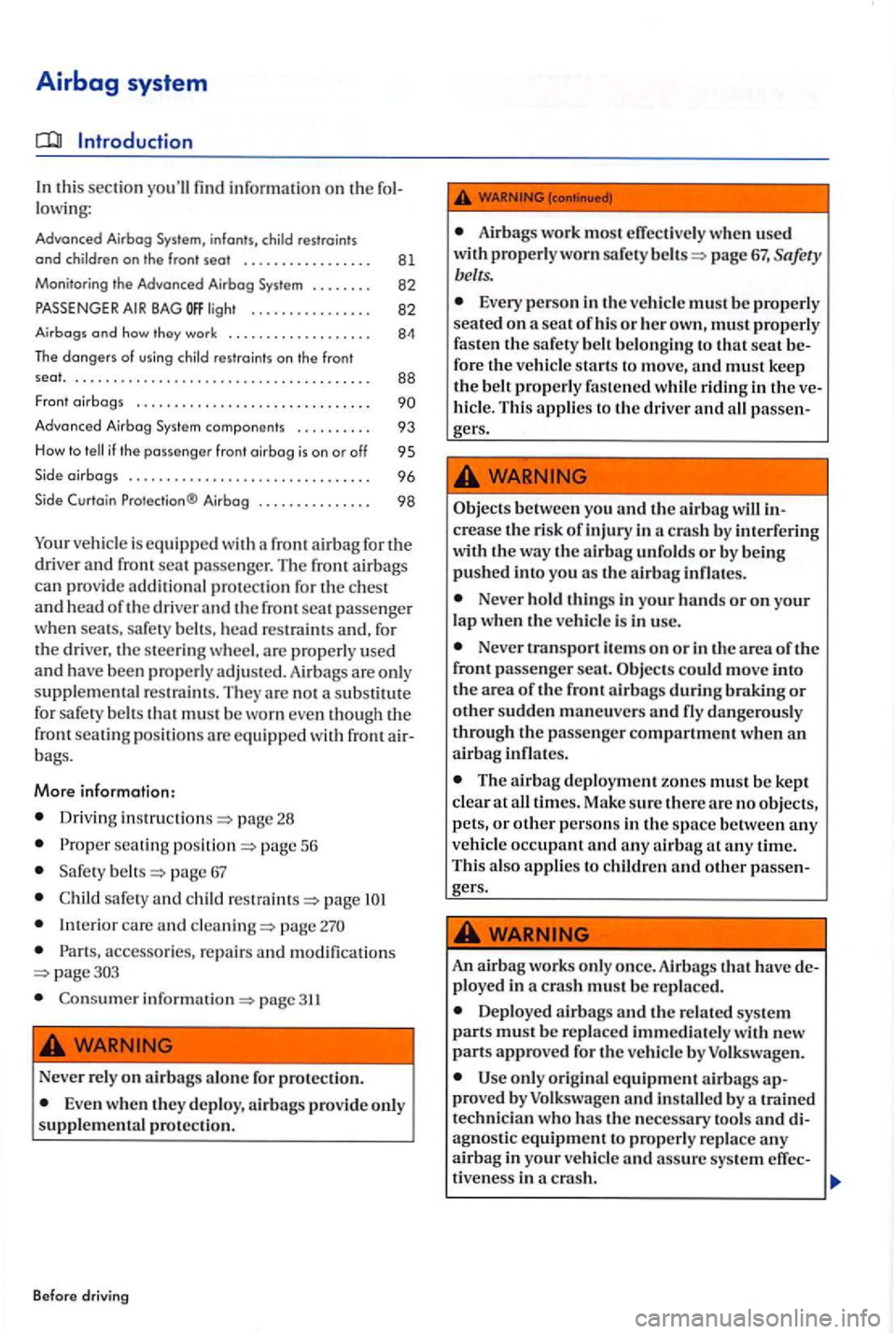
Airbag system
find information on th e fol
low ing :
Advanced Airbog
. 82
. . . . . .
Advanced Airbog Sys tem compon e nt s . . . . . . . . . . 93
H ow to if the passenger fron t oirbog is on or off 9 5
. . . . . . 98
Your vehicle is e quipped a front air bag for the
d ri ve r an d fro nt pa sse nger. The front airbag s can pro vide additional p ro tec tion fo r th e ch est and h ead of th e driver and the fro nt sea t p assenge r seats, sa fe ty belts, h ead re stra int s and, for
the driver, th e s teerin g whee l, are prop erly use d and have bee n properly adjusted. Airb ags are on ly
s u pplemental restraints. Th ey are not a su bstitut e for sa fe ty belt s th at must be wo rn eve n though front seatin g pos itions are equipp ed wit h front air
bag s.
More information:
Driv ing instru ction s=> page
seating position=> pag e 56
Safe ty belts=> page 67
sa fe ty and child pa ge
care and pag e
accessories, re pa ir s and modifica tion s pag e303
informati on=> page 311
Never rely on a irbags alone for protect io n.
Eve n when th ey deploy, airbags provide only
s uppl em ental protec tion.
Be fore driving
Airbag s work most effec tive ly w hen used
with properl y worn safe ty belt s=> page 67,
Every perso n in the ve hicl e must b e prop erl y seated on a seat of hi s or he r own, must properl y faste n th e safet y belt belongi ng to th at seat b e
for e the vehicle sta rt s to move, and must ke ep the belt properly faste n ed whil e riding in the ve
hicle. Th is a pplie s to the driv er and all
Obj ects between you an d the airbag will crease the risk of injury in a crash by interfe rin g
witl1the way the airbag unfolds or by being push ed into you as the a irbag inflates.
Never h old th ings in your hand s or on your lap when the vehicl e is in use.
Never items on or in th e area of th e
front passe nger seat. Ob jects could move into
th e a rea of the front airbag s during braking or other sudden maneu ve rs and fly dan gero usly
through the passe nge r compartment when an airbag infl ates.
The airbag deploym ent zones must be kept
clear at all tim es. Make sure there are no objects ,
pets, or ot her persons in the space be tween any ve hicl e occupant and any airb ag at an y time. Thi s also applie s to c hildr en and o ther pa sse n
gers .
WARNING-
An airb ag works o nl y once. Airbag s th a t h ave de
plo yed in a cras h must be re placed.
Deployed airbag s and the re lated sys tem
p art s must b e repla ced immediately with new parts approved for the ve hicl e by Volkswagen.
Use o nly orig inal equipment airb ags ap
prov ed by Volkswag en and by a trained
techni cian who has the necessary too ls and di
agnostic eq uipmen t to properl y replace an y airbag in your ve hi cle and assure sys te m effec-
ti veness in a c rash.
Page 98 of 541

door and the backre st. T he general locatio n is
s hown b y th e The area s marked in (dotted lin es)=> 62 in dicate the deploy
m ent zones of the s ide airbags.
Durin g a s ide colli sio n , the sid e airbags in the backres t ca n deploy. there by redu cing th e risk of inju ry to ve hicle occupants.
The side airbag system includes :
ele ctroni c control m odule and side impact sensors .
Sid e ai rbags in the fro nt backrests and , where applicable, sid e airbags in the rear backrests .
An airb ag monito rin g sy ste m an d indicator light in the in strumen t clu ste r
W hen a side a irbag deploys in a coll is io n, a gas gene ra tor the side airbag b etween the vehicle occupant and the door. Th e side airbag syste m
supple m ents th e safety belt s and ca n help toreduce the ris k of injury to the occupants' upper torso .
In ord er to help pro v
ide this additio nal protection, the sid e airbag must infl ate w ithin the bl ink of an eye at very hi gh sp ee d and w ith great force. The supplemental side a irbag co uld injure yo u if your seating position is not proper or upright or ifitems are in the area where the supplemental sid e airbag inflate s. Thi s applies especiall y to children
w ill co m e on for a few seconds
(self- d iagnos is).
The airbag syste m i s no t a s ubstitute for your safety be lt. Rather, it is part of the ov era ll occ upant restra int system in your ve hicle=> page 56,
re ad y dep lo ye d.
properly and safe ly
The side airbag sys tem
if the ignition i s sw itched ofT wh en a crash occurs,
in side c o lli sio ns wh en the a cce le rat ion mea
s u re d b y the sensor is to o low,
in front-end collis ion s,
in re a r-end collis ion s,
in rollovers, unless the depl oy men t threshold for deploym ent stored in the control unit is met.
I n s
ome ty pes of accid ent s the front airbags , Sid e
C urtain airbag s and sid e airb ags may
b e triggered together.
A n Inflatin g side a irbag can cause serious or even fatal injury. Improp erly wearing safet y
b elt s and improp er seatin g po siti ons increase
th e risk of se riou s persona l injury and death
whenever vehicle is being used.
To help reduce the risk of injury when the
supplemental sid e a irb ag inflat es,
- Always sit in
an upright po sition and do
not l ea n agai nst th e area where the s ide
airbag is located.
- Neve r le t a c hild or anyo ne e lse rest their
head again st th e s ide trim panel in the area
where the s ide ai rbag inflates.
- Never let anyo ne s itting in the front
seat put their hand out o f window.
betw een yo u and the airba g ca n in
crease the risk of injury in a colli sion by inter
fering with the way the airbag unfolds or by
being pushed into you as th e airbag inflates.
Never pla ce or attach a ccess ories or other ob
je cts (su ch a s cup holders, telephone bracke ts , or eve n large , bulky objects) on the doors or over or ncar th e area mark ed p age 96, fig. 6 1.
Accessories or other object s ca n fly dangerously
throu gh the passe nger compart ment and cau se serio u s injury if the supplemental sid e airbag
Neve r position or hol d any obje cts o r pet s in the
deplo yment space of an airbag or allow any child
r e n or other passenge rs to trave l in s uch a pos ition .
Never use th e built -in coat hook s for any thin g but lightweig ht clothing . Neve r leave
any heavy or sharp- edged objects in the pockets. objects may interfere w ith side airbag de
pl oy ment and cau se seriou s personal injury in a
co llisio n.
96 97
Page 99 of 541
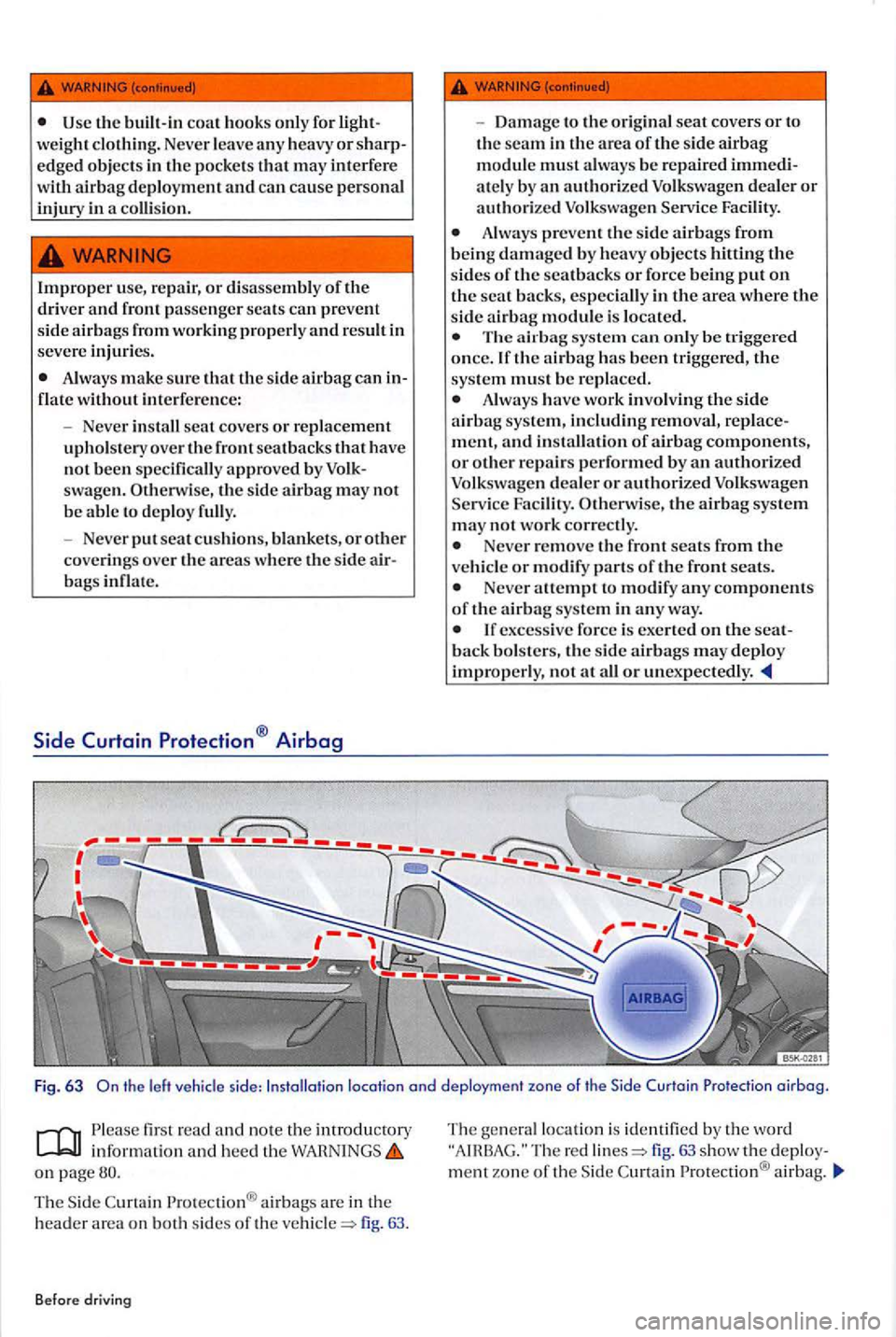
Always make sure that th e side airbag can inflate without interfe re nce :
- Neve r in sta ll
seat covers or replacement uphols tery over th e front seat backs that h ave
not been specifically approved by Volk
swage n. the s ide airbag may not
b e able to deploy fully.
-Neve r put seat c u shi ons, blanke ts , or other cove rings over th e areas where th e s ide ai r
b ags inflate.
Side Curtain Protection ® Airbag
-Damage to th e original seat covers or to the seam in the area of the si de airbag module must a lways be repaired imme di
a te ly by an au thorized Vol kswagen dealer or authorized Volkswage n Service Facility.
Always prevent th e sid e airbags from
b eing damaged b y heavy objects hitting the
s ides of the seat back s or force be ing put on the scat backs, especially in the area w here the
s id e a irbag modul e is located. The air bag sys te m
A lways have work involving the s ide airbag system, including removal, rep lacement, and ins talla ti on of airbag compo n en ts, or other re pairs performed by an authorized Volkswagen deale r o r authorize d Volkswage n
Service Facility. the airbag system may not work correctly. Neve r remove th e front seats from th e vehicl e or modify parts of the front seats. Never attempt to modify a ny components of the air bag system in any way. I f excess ive force is exerted on the seatback bols te rs, the s ide airbags may deploy not at al l o r
Fig. 63 th e left ve hicle side: In stallation location and deploym ent zone of th e Side in airbag.
information and h eed th e WARNINGS on page
Th e Sid e C urta in ai rbags are in the
h eader are a on bot h sid es of th e fig. 63.
Befo re driv ing
The ge nera l lo ca tion is id entified by the word The red fig. 63 sho w th e deploymen t zo ne of the Sid e Cu rtain airbag .
Page 100 of 541
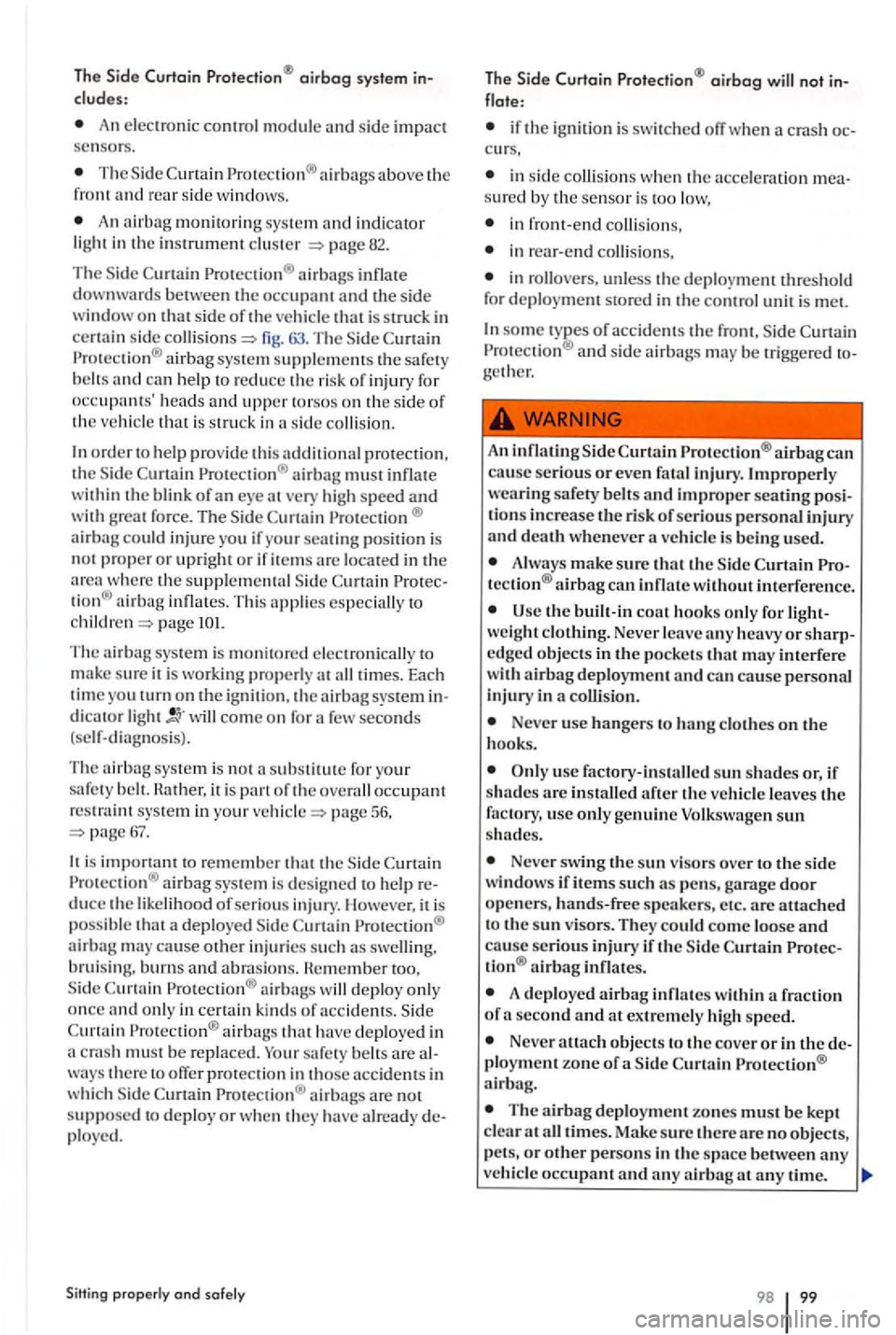
The Side Curtain airbag system in
An elec tron ic control module and side impact se nsors.
T he above th e
f ro nt
An monitoring sys te m 82.
Th e
airbags betwee n th e
fig . 63 . The airbag system supplem ents th e sa fety bel ts can help to reduce th e risk o f injury for occupants' heads and uppe r to rsos on the sid e of the that is s truck in s id e
order to he lp provid e thi s additional p ro tectio n,
t h e
w it h in the bl in k of an eye high speed and wi th grea t force. The airbag could injure you if your positio n is
n ot prope r o r upright or if ite ms arc locate d in the area w he re the supp le m ental airbag to page
sys te m is monitored e lectro nically to
make sure it is workin g properly at times. Eac h time you tu rn on the ignit io n , the airbag sys te m dicato r come on for few seconds
( s clf-d iag nosis).
Th e
airbag sys te m i s not it is part of th e ove rall occupant res tra int sys te m in your page 56,
is important to remember the airbag sys te m is desig ned to help reduce the like lihood of ser iou s inju ry. H oweve r, it is possib le that a deployed m ay cause oth e r in juries s u ch as bruising, burns and abras io ns. Hc m ember too ,
airbags that have deploye d in sa fe ty be lts areal
way s th ere to offer protection in those accidents in
w hich
The Side Curtain airbag
if the ign ition is switched w hen occurs,
in sid e collisions w he n the accele ra tion m ea
sure d by th e sensor is too low,
in front-end
in rear-end
in over s , unless the deployment thresh o ld
f o r deploym ent sto red in the control unit is met.
some ty pes of accidents th e front, and sid e airbags m ay be triggered togeth er.
inflating airbagcan cause serio us or even f ata l injury . wearing safety belts and improper seating positions increase the risk o f serious personal injury and death whenever a is being used.
A lway s make sure tection® can inflate without interference.
or sharp
edge d objects in the pockets that interfe re
with deployment and c a use personal injury in a
Never u se hangers to on the
hooks.
use facto ry-ins talled sun shades or, if are the leaves the usc only genuine Volkswagen sun shades.
Neve r swing the sun viso rs ove r to the s ide
windows if it ems such pens, door o pe ne rs, hands -free speakers, etc. arc attached to t he su n visors. They could come lo ose and cause serious injury if the
deployed airbag second and at extreme ly high speed.
Neve r objects to the cover or in the deployment zone of a Curtain
The
between a ny
v ehicle occupant and a t
98 99
Page 103 of 541
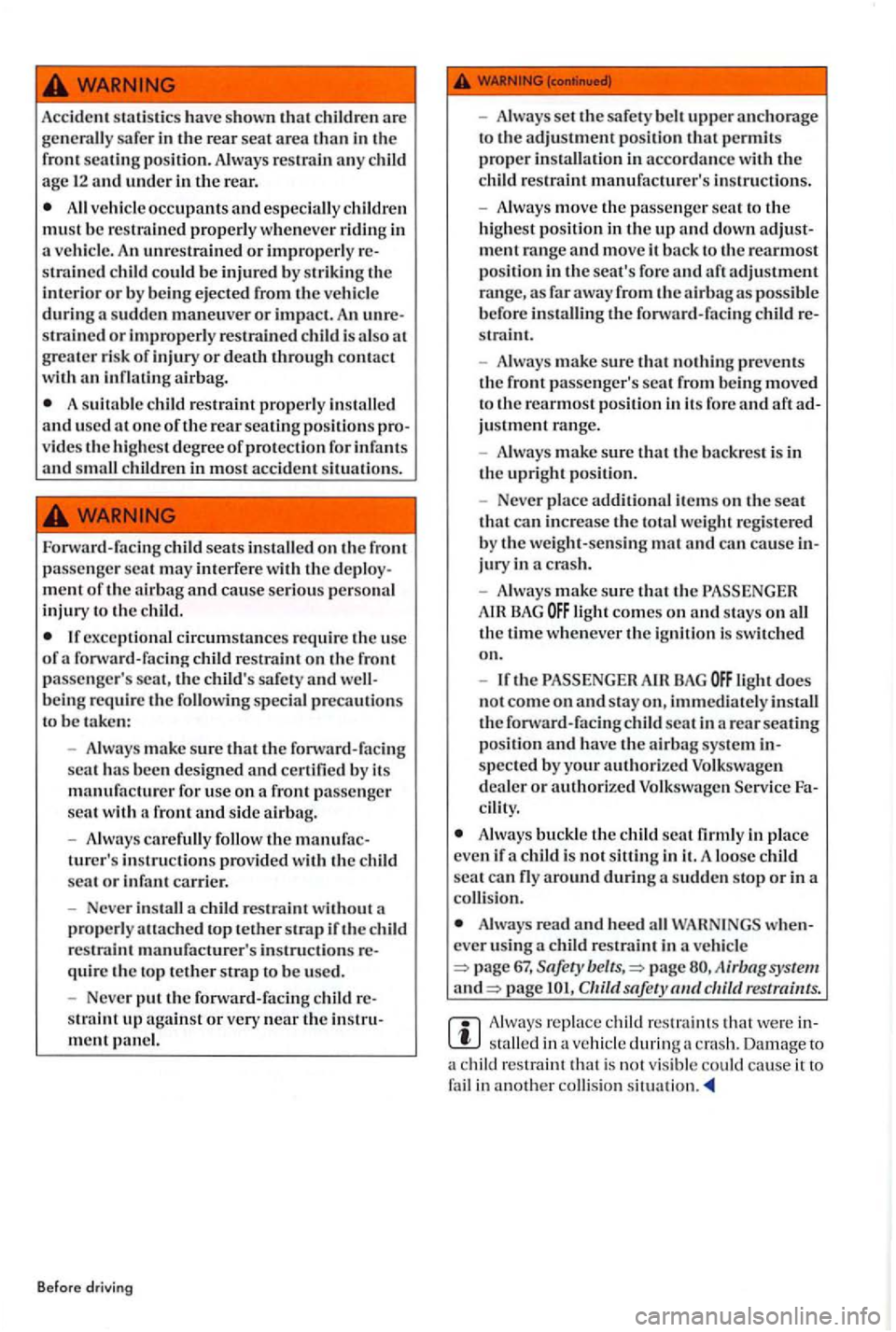
Accident stati sti cs have shown childr en are
generally safer in the rear seat area than in the front restrain any child age 12
All ve hicl e occupants and especially childr en must be restrai ned properly whenever ridin g in vehicle. An unrestrained or improperly strained child could be injured by striking the
interior o r by being ejected from the vehicle during sudden maneuver or impact. An strained or improp erly restrained child is at
airbag.
suitab le child rest raint properl y install ed and used
Forward-facing child seals installed on the front passenge r seat may interfere with the ment of th e a irbag and cause serious personal injury th e c hild .
exceptional circumstances require the u se of fonvard-fac ing child restraint on the front
passenger's seat, the child's safety and being requir e th e following special preca utions to be taken:
- Always
make sure that the fonvard-faci ng seal has bee n designed and certifi ed by its
m anufacturer for use on
ch ild res traint without top tether strap if the child
restraint manufacturer's instructions quire the top tether strap to be u sed.
- Never
putt he fonva rd-facing chil d
ment panel.
Before driving
-Always set the safety bell upper anchorage to the adjustmelll position permits
p roper
in the up and down
position in the seat's fore and aft adjustment range, as far away from the airbag as possib le
before installin g the fonvard -facing child s traint .
- Always
make sure that nothing prevents t h e fro nt passeng er' s scat fr o m being moved
justment range .
- Always
make sure that the backr est is in
th e upri ght position.
- Never place ad dit ional it
ems on the seal
th at can in crease th e total weight registered
b y the weight-se nsing mal cause jury in a crash.
- Always
make sure
BAG light does
not come on and stay on, immediately install
t h e fonvard-facingchi ld seat in rear seating sys tem spected by your authorized dealer or auth ori ze d Se rvice
A lways buckle the child seal in place
even if loose child seat ca n around during a sudd en slop or in a
Always read and heed all WARNINGS ever using child res train t in ve hicl e 67, Safety page 80,Airbagsystem page safety
A lways replace child restraint s that were s talled in cras h. Damage to
a child res traint that is not visib le co uld cause it to fail in another collision situati on
Page 107 of 541

Alw ays follow the child restraint manufacturer's in stalla tion
tion in th e se at's up and down adjustm ent range and to th e rearmost p osit ion in th e se at's fore and aft adj ustment ra nge, as far away from the air ba g
a s poss ib le before in sta llin g th e forwa rd-facing
chil d res train t a nd mak e sure th e backre st is in th e
upr ig ht
If a te th er str ap is being used to tie the child s traim to th e front passe nger seat, make su re that
it is not so tigh t that it causes the we ight-se nsin g mat to meas u re m ore weig h t than is actu ally on
the seat.
Alway s remember: E ven though your vehicl e is
e qu ipped with an Advanced Airb ag System, all
child re n , es pecially th ose 12 years and younger, mus t a lways ride in the back seat pro pe rly
tion.
All ve hicl e oc cupants and esp ecially childr en must always be restrain ed proper ly w he neve r
ridi ng in a vehicle.
-
An unres tra ined or imp roperly restrained
c hild can be injured or kill ed by being thrown
agai nst th e in sid e of the vehicl e or by bein g
e je cte d f rom it duri ng a sudden maneuver o r impact.
- An
unrestrai ned or improperl y re strained
c hild is also at much grea te r risk of inju ry or death by be ing stru ck by an inflat ing ai rb ag.
Commercially available chil d seats must comply w ith U.S. Federal Motor Vehicle Standard 213).
- When buyin g a restraint, selec t o n e
th at your child and the ve hicle.
-
usc c hil d restra int sys te m s th at m ake
f ull contact with the flat portion of the scat cushion. Th e c hild restraint mus t n ot tip or
l ea n to ei ther side. Volk swa gen docs not ommend using child sea ts res t o n legs o r
t u be-like frame s. They do not prov ide qua te con ta ct wit h the seat.
Befo re driving
- Alwa ys heed all legal requ irement s ta ining to the in sta ll ation and use of child
sea ts and carefully follow the in structi ons
provid ed b y th e manufacturer of th e seat y ou arc using.
For safet y reasons, never allow child re n under 4ft. 9 in (57 in che s /1.45 mete rs) to wear a
normal3-p oint safety belt . They must a lways be r est rain ed b y a proper child rest rain t syste m .
O th erwi se, they could su stain injuries to domen and neck areas during sudden bra kln g
m an euver s or acci dents.
Neve r le t more th an one child occupy a ch ild
se at.
Neve r let babie s or older child ren ride in hicl e whil e sittin g on the lap of another senger.
- Holdin g a ch ild in
your arms is never a
subs titut e fo r child res traint syste m .
-
The stronges t perso n wou ld no t b e able to
hold c hild, give n th e for ces present durin g
a co llision. The c hild will strike th e interior of the ve hicl e and can also be impacte d by ot her pa sse nge r.
-
The c hild and the pass enger ca n als o jure eac h other in an acciden t.
Neve r in sta ll reanvard-facing ch ild sca ts or i n fa nt carri ers on the fron t p assenge r sea t. A
c hild will be se riously injure d and ca n b e kill ed
w he n th e pa sse nger airbag inflates-even with
a n Adva nce d Air bag System.
A lways install reanvard-facin g child scats or infant on th e rear scat.
Fonvard-fac in g child seats in sta ll ed on the
front passenge r's sca t can interfere with the airb ag wh en it inflates and ca use seriou s injury
to the ch ild . Always in stall forward -facin g child
sc ats on th e rear sea t.
fonvard-facing child restraint on th e front passe nger's sea t, th e c hild 's safety an d bein g require the followin g speci al precauti on s
to be take n:
Page 112 of 541
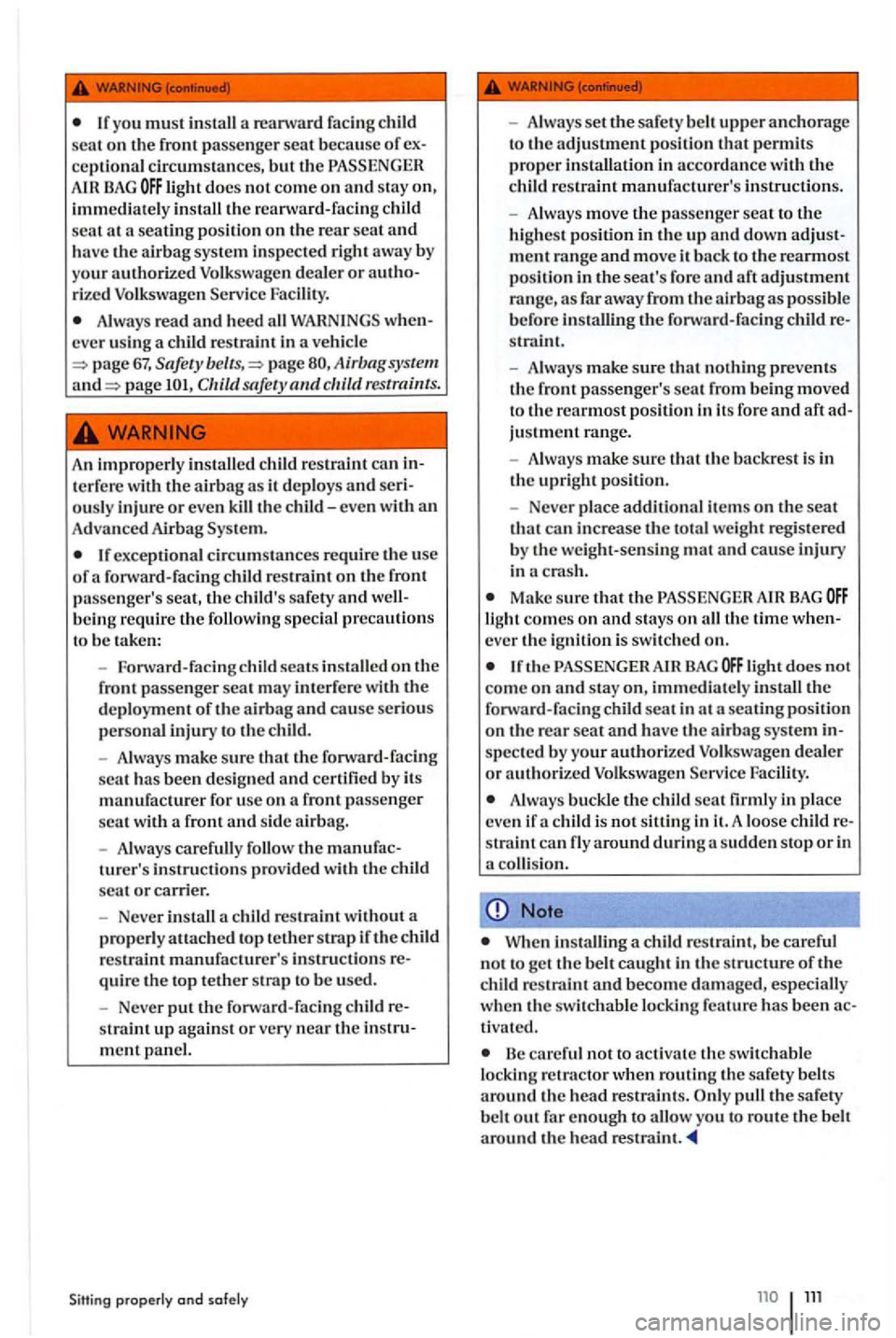
you must install a reanvard facing child
seat on th e front passe nger seat b eca use of ce pti ona l circumstances , but the light does not come on and stay
Facil ity.
Alway s read and heed all
page Safety pag e Airbn g sys te m page safety restraints.
An improperly installed child res traint can terfe re w it h th e airbag as it de plo ys and ously injure or even kill the child -eve n w ith an Advanced Airbag
being require the following sp ecia l precautions
to be tak en:
-
Fonvard-facing child seats in stalle d on the front passe nger seat may interfere with the de ploym ent of the airbag an d cause se riou s
p ersonal inju ry to th e c hild.
- Always make s
ure that the fonvard-facing seat has been des igned and certified by its manufacturer for use on a front passe nger seat wit h a front and sid e airbag.
- Always care full y follow the ture r's in struction s prov ided with the c hil d scat or carrier.
- Never install a child res traint w
ithout a properly attach e d top tether strap if the child
res traint manufacturer's instructions quire the top te th er strap to be u sed.
- Neve r
put the fonva rd-faci ng c hild straint up agains t o r very nea r the
properly and safely
- Always set the safe ty belt upper a n ch orage
t o th e adjustment positi on tl1at permit s proper in stallation in accordance with th e child restraint manufacture r' s in struction s.
- A
lways move the passenger seat to the
hi ghest position in the up and down
justment range.
- Always
make sure that th e backres t is in
th e upright position .
- Never place
additional items on the seat th at can increase the tota l we ight regi ste red by the weight-se nsing mat and cau se injury
in a c rash .
Mak e sure that the BAG
If the BAG OfF light does not com e on and sta y immediately in stall the fonvard -facing child seat in at a seatin g position on the rear seat and have the airbag sys te m
Fac ility.
Always buckle the c hild seat in place even if a child is not sitti ng in it. A loose child
collisio n.
Note
When installing a child res traint , b e ca reful
not to get the belt caught in tl1c structure of tl1e child res traint and become damaged, especia lly when the swi tc habl e lo ckin g feature has been tivated.
Be careful not to activa te th e sw itch a bl e
lo ckin g retra ctor when routin g th e safety belt s
a round the head restraints . p ull the safety
b elt out far enough to allow you to route tl1e belt around th e head restraint.
Page 118 of 541

seating position: Guide the upper te th er
s trap under th e o uter r ear head restra int (raise th e
h ead restra int if n ecessary).
Guide th e te th er strap betwe en th e re ar seat back and the lu ggage compartment cove r.
A ttach th e tether s trap an chorage hoo k
After you have install ed th e c hild seat, pull on bot h of t he adju stabl e strap s o n th e child sca t and p ull also on th e te th er strap to m ake certain the seat is sec ure an d prop erly attac hed.
R e le asing
L oose n th e te nsion o n th e strap followin g the chi ld re straint manufa ctu re r's in structio ns.
De press th e s pring ca tc h on th e hook.
tio n.
Move the hoo k in the dir ection of the vehicle floor so th at th ere is e no ugh sp ace to release the connector from the lo wer a n chora ge.
Release the teth er strap.
You must take sp ecia l preca utions w he n in sta lling
a child res traint w ith the vehicle safety belt or with
w ays route th e unuse d ce nt er scat s afe ty belt and th e unused safety belt for th e seatin g posit io n
w here the child restraint is be in g in stalle d
around th e rear h ead restrain! behind the c hild stra int to help preve nt a chil d from play ing w ith
th e unused b elt and beco min g e ntan gled in it.
Improper use of the sys tem can increase th e risk of serio us person a l inju ry and death in an accid ent.
Alway s care fully fo ll ow the child re straint manufacture r's in structions for proper
vers al anchorages or safety belts in your ve hicl e.
Never mount two lower unive rsal a nchorage point.
These anchors w ere developed only for c hild seats using th e sys tem.
Neve r attach other ch ild seats, be lts, lugg age or other thin gs to the anchorages.
Alway s make s ure that you hear a
the seat is not secure and co uld fly fo rward
and hit the interior of th e ve hicl e or be ejected from the ve hicle.
Be careful not to activa te th e sw itchab le
pull the
safety belt out fa r en o ugh to allow you to route th e
b el t around th e hea d restrai nt.
116 117